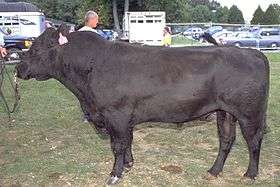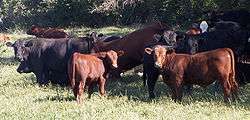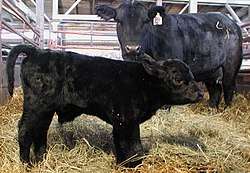Angus cattle
The Aberdeen Angus, sometimes simply Angus, is a Scottish breed of small beef cattle. It derives from cattle native to the counties of Aberdeenshire and Angus in north-eastern Scotland.[1]
 A Black Angus bull | |
| Conservation status | Least Concern |
|---|---|
| Other names | Aberdeen Angus |
| Nicknames | Doddies Hummlies |
| Country of origin | Scotland |
| Distribution | Europe, Australasia, Southern Africa, North America, South America |
| Use | Beef |
| Traits | |
| Weight |
|
| Skin color | black |
| Coat | Black or Red |
| Horn status | Polled |
| |
The Angus is naturally polled and solid black or red, though the udder may be white. The native colour is black, but more recently red colours have emerged.[2] The United Kingdom registers both in the same herd book, but in the United States they are regarded as two separate breeds: Red Angus and Black Angus. Black Angus is the most common breed of beef cattle in the US, with 332,421 cattle registered in 2017.[3] In 2014, the British Cattle Movement Service named Angus the UK's most popular native beef breed, and the second most popular beef breed overall.[4]
History
Scotland
Aberdeen Angus cattle have been recorded in Scotland since at least the 16th century in the country's northeast.[5] For some time before the 1800s, the hornless cattle in Aberdeenshire and Angus were called Angus doddies.
In 1824, William McCombie of Tillyfour, MP for South Aberdeenshire, began to improve the stock and is regarded today as the father of the breed.[2] Many local names emerged, including doddies or hummlies. The first herd book was created in 1862, and the society was formed in 1879. This is considered late, given that the cattle gained mainstream acceptance in the middle of the eighteenth century. The cattle became commonplace throughout the British Isles in the middle of the 20th century.[6]
Argentina
As stated in the fourth volume of the Herd Book of the UK's Angus, this breed was introduced to Argentina in 1879 when "Don Carlos Guerrero" imported one bull and two cows for his Estancia "Charles" located in Juancho, Partido de General Madariaga, Provincia de Buenos Aires. The bull was born on 19 April 1878; named "Virtuoso 1626" and raised by Colonel Ferguson. The cows were named "Aunt Lee 4697" raised by J. James and "Cinderela 4968" raised by R. Walker and were both born in 1878, on 31 January and 23 April respectively.[7]
Australia
Angus cattle were first introduced to Tasmania (then known as Van Diemen's Land) in the 1820s and to the southern mainland in 1840. The breed is now found in all Australian states and territories with 62,000 calves registered with Angus Australia in 2010.[8]
Canada
In 1876 William Brown, a professor of agriculture and then superintendent of the experimental farm at Guelph, Ontario, was granted permission by the government of Ontario to purchase Aberdeen Angus cattle for the Ontario Agricultural College. The herd comprised a yearling bull, Gladiolus, and a cow, Eyebright, bred by the Earl of Fife and a cow, Leochel Lass 4th, bred by R.O. Farquharson. On 12 January 1877, Eyebright gave birth to a calf, sired by Sir Wilfrid. It was the first to be born outside of Scotland. The OAC went on to import additional bulls and cows, eventually began selling Aberdeen Angus cattle in 1881.[9]
United States
On 17 May 1873, George Grant brought four Angus bulls, without any cows, to Victoria, Kansas. These were seen as unusual as the normal American cattle consisted of Shorthorns and Longhorns, and the bulls were used only in crossbreeding. However, the farmers noticed the good qualities of these bulls and afterwards, many more cattle of both sexes were imported.[10]
On 21 November 1883, the American Angus Association was founded in Chicago, Illinois.[11] The first herd book was published on March 1885.[10] At this time both red and black animals were registered without distinction. However, in 1917 the Association barred the registering of red and other coloured animals in an effort to promote a solid black breed.[12]
The Red Angus Association of America was founded in 1954 by breeders of Red Angus cattle. It was formed because the breeders had had their cattle struck off the herd book for not conforming to the changed breed standard regarding colour.[12]
Characteristics
Because of their native environment, the cattle are very hardy and can survive the Scottish winters, which are typically harsh, with snowfall and storms. Cows typically weigh 550 kilograms (1,210 lb) and bulls weigh 850 kilograms (1,870 lb).[14] Calves are usually born smaller than is acceptable for the market, so crossbreeding with dairy cattle is needed for veal production.[14] The cattle are naturally polled and black in colour. They typically mature earlier than other native British breeds such as the Hereford or North Devon. However, in the middle of the 20th century a new strain of cattle called the Red Angus emerged.[15][16] The United States does not accept Red Angus cattle into herd books, while the UK and Canada do.[16] Except for their colour genes, there is no genetic difference between black and red Angus, but they are regarded as different breeds in the US. However, there have been claims that black angus are more sustainable to cold weather, though unconfirmed.[16]
The cattle have a large muscle content and are regarded as medium-sized. The meat is very popular in Japan for its marbling qualities.[17]

Genetic disorders
There are four recessive defects that can affect calves worldwide. A recessive defect occurs when both parents carry a recessive gene that will affect the calf. One in four calves will show the defect even when both parents carry the defective gene. The four recessive defects in the Black Angus breed that are currently managed with DNA tests are arthrogryposis multiplex (AM), referred to as curly calf, which lowers the mobility of joints; neuropathic hydrocephalus (NH), sometimes known as water head, which causes an enlarged malformed skull; contractural arachnodactyly (CA), formerly referred to by the name of "fawn calf syndrome", which reduces mobility in the hips; and dwarfism, which affects the size of calves. Both parents need to carry the genes for a calf to be affected with one of these disorders.[18][19][20] Because of this, the American Angus Association will remove the carrier cattle from the breed in an effort to reduce the number of cases.[21]
Between 2008 and 2010, the American Angus Association reported worldwide recessive genetic disorders in Angus cattle. It has been shown that a small minority of Angus cattle can carry osteoporosis.[22] A further defect called notomelia, a form of polymelia ("many legs") was reported in the Angus breed in 2010.[23]
Uses
The main use of Angus cattle is for beef production and consumption. The beef can be marketed as superior due to its marbled appearance. This has led to many markets, including Australia, Japan and the United Kingdom to adopt it into the mainstream.[17] Angus cattle can also be used in crossbreeding to reduce the likelihood of dystocia (difficult calving), and because of their dominant polled gene, they can be used to crossbreed to create polled calves.[24]

Commercial
Starting in the early 2000s, the American fast food industry began running a public relations campaign to promote the supposedly superior quality of Angus beef. Beginning in 2006, McDonald's commenced testing on hamburgers made with Angus beef in several regions in the US. After this test, the company said that customer response to the burgers was positive[25] and began selling the burger made with Angus beef in all US locations in July 2009.[26] In response to the test in the US, McDonald's Australia began selling two Angus burgers, the Grand Angus and the Mighty Angus, using Australian-bred Angus, in their restaurants.[27]
The American Angus Association created the "Certified Angus Beef" (CAB) standard in 1978. The purpose of this standard was to promote the idea that Angus beef was of higher quality than beef from other breeds of cattle. Cattle are eligible for "Certified Angus Beef" evaluation if they are at least 51% black and exhibit Angus influence, which include black Simmental cattle and crossbreds. However, they must meet all 10 of the following criteria, which were refined in January 2007 to further enhance product consistency, in order to be labelled "Certified Angus Beef" by USDA Graders:[28]
- Modest or higher degree of marbling
- Medium or fine marbling texture
- "A" maturity
- 10 to 16 square-inch ribeye area
- Less than 1,050-pound hot carcass weight
- Less than 1-inch fat thickness
- Moderately thick or thicker muscling
- No hump on the neck exceeding 5 cm (2")
- Practically free of capillary rupture
- No dark cutting characteristics
- Usually black or red in color
See also
- List of Cattle breeds originating in Scotland
- List of cattle breeds
References
- Encyclopædia Britannica 15th Ed. Vol.10 p.1280
- "Oklahoma State University Red Angus breed profile".
- "Frequently asked questions about the world's largest beef breed registry". American Angus Association. 11 April 2018. Retrieved 11 April 2018.
- "Aberdeen-Angus breed increases influence on British Beef industry" (16 March 2015). Aberdeen Angus Cattle Society. Retrieved 29 April 2015.
- "Britannic Rare Breeds – Angus Cattle". Britannic Rare Breeds. Archived from the original on 20 June 2015. Retrieved 25 June 2015.
- "The Cattle Site – Angus Breeds". The Cattle Site. Retrieved 25 June 2015.
- Historia de la Cabaña Charles de Guerrero, criadora de Angus desde 1879 Archived 8 February 2016 at the Wayback Machine
- "Archived copy" (PDF). Archived from the original (PDF) on 22 March 2012. Retrieved 28 August 2013.CS1 maint: archived copy as title (link)
- "First Herd of Aberdeen-Angus Established by OAC in 1876". Kitchener-Waterloo Record (Microfilm). 6 March 1954. p. 2.
- Burke, Tom; Kurt Schaff; Rance Long (2004) [2004]. "The Birth of the Breed". Angus Legends: Volume 1. p. 17.
- American Angus Association. "Angus History". angus.org. Archived from the original on 24 September 2006. Retrieved 2 October 2006.
- Red Angus Association of America. "History of Red Angus". redangus.org. Archived from the original on 24 September 2006. Retrieved 2 October 2006.
- "German Angus cattle information". Interboves. Retrieved 10 August 2015.
- RBST. "Aberdeen Angus (Native)". Factsheet. Kenilworth, Warwickshire: Rare Breeds Survival Trust. Archived from the original on 30 June 2015. Retrieved 25 June 2015.
- "Encyclopædia Britannica – Cattle Breeds". Encyclopædia Britannica. Retrieved 25 June 2015.
- "Red Angus History" (PDF). p. 2. Retrieved 2 August 2015.
- "New South Wales Agriculture – Angus cattle". Archived from the original on 24 June 2015. Retrieved 25 June 2015.
- Denholm, Laurence. "Congenital contractural arachnodactyly ('fawn calf syndrome') in Angus cattle" (PDF). NSW Department of Trade and Investment PrimeFact 1015 May 2010.
- Vidler, Adam, Defects on rise as gene pool drains, p. 63, The Land, Rural Press, North Richmond, NSW
- Another genetic defect affects Angus cattle Retrieved on 29 May
- "American Angus Association". Angus.org. Retrieved 14 May 2012.
- Whitlock, Brian K. "Heritable Birth Defects in Angus Cattle" (PDF). Appliedreprostrategies.com. Retrieved 24 August 2015.
- "Denholm L et al(2010) Polymelia (supernumerary limbs) in Angus calves".
- "Angus". Cattle Today. Archived from the original on 17 October 2006. Retrieved 29 October 2006.
- Weston, Nicole (8 March 2007). "New Angus Third-Pounders at McDonald's". Slashfood. Archived from the original on 28 September 2011. Retrieved 14 May 2012.
- "McDonald's to debut $4 Angus burger". NBC News / The Associated Press. Retrieved 1 July 2009.
- "McDonald's – Angus Beef". McDonald's Australia.
- "Angus FAQs". American Angus Association. Retrieved 2 August 2013.
External links
| Wikimedia Commons has media related to Angus cattle. |
- History of the Angus cattle – Oklahoma State University
Breed associations
Unless otherwise stated, the associations below register both red and black animals.
- Official website of the Aberdeen Angus Cattle Society
- Irish Angus Cattle Society Ltd.
Australia:
Canada:
Denmark:
New Zealand:
Portugal
US:
- American Angus Association – responsible for black Angus registrations, but does not register red Angus cattle.
- Red Angus Association – responsible for red Angus registrations, and will also register black Angus cattle.
- A*L*O*T Angus Association (Arkansas, Louisiana, Oklahoma, Texas) – represents the owners of black Angus cattle in four states.
- Iowa Angus Association—represents the owners of black Angus cattle.
- Miami Valley Angus Association—represents the owners of black Angus cattle.
- Texas Angus Association—represents the owners of black Angus cattle in the State of Texas.